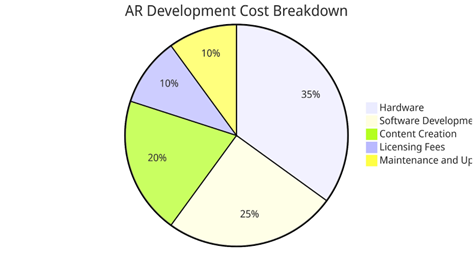Augmented Reality (AR)
Augmented Reality, or AR for short, is a way to add computer-made images or information to the real world. This can be done using devices like smartphones, mobile application, tablets, or special glasses. With AR, you can see virtual things in your real surroundings. This technology is becoming more and more important as it’s being used in games, shopping, education, and even medicine.
Factors Influencing AR Development Costs Understanding the various components that shape the price tag of an AR project is crucial. Here’s a deeper dive:
- Hardware Requirements: Not all AR experiences are created equal. Some can be accessed via a standard smartphone, while others might require advanced headsets or glasses. The type and specifications of the hardware will play a pivotal role in determining the budget.
- Software Complexity: Simple AR overlays that display static information are on one end of the spectrum, while intricate, multi-layered interactive experiences represent the other end. The complexity level is directly proportional to the cost.
- Content Creation and Licensing: Whether you’re creating your visuals and animations or procuring them, this aspect requires substantial financial planning.
Cost Breakdown: Hardware
When we talk about Augmented Reality (AR), the first thing that might come to mind is the device through which we experience this technology. The device plays a pivotal role as it not only displays the augmented content but also processes it in real-time. Here’s a more detailed breakdown:
Different Types of AR Devices and Their Costs:
1. AR Glasses and Headsets:
- HoloLens: Created by Microsoft, HoloLens is one of the industry leaders when it comes to AR headsets. These are standalone devices, meaning they don’t require a connection to a computer or a phone. They overlay digital images onto the real world. Given their advanced tech, they are on the pricier side.
- Magic Leap: Another significant player in the AR headset market. Magic Leap provides a unique spatial computing experience that interacts with the real world.
The costs for these advanced AR glasses can range anywhere from $2,500 to $5,000 or even more, depending on the version and features.
2. Smartphones and Tablets:
- Common devices like the iPhone (with ARKit) or Android devices (with ARCore) have become potent tools for AR. They use their cameras to display the real world on their screens and then overlay it with digital content.
- The price range here is broad, from $300 for basic smartphones that support AR to $1,200 and above for high-end models.
Importance of Device Compatibility:
1. Broader Audience: Making your AR experience available across different devices ensures that more people can access it. Whether someone has a basic AR-supported smartphone or high-end AR glasses, you wouldn’t want to miss out on any segment of your audience.
2. Development Costs:
Designing for multiple devices can increase initial development costs. Each device might have its specifications, screen sizes, and processing capabilities. It means your AR application needs to be flexible and adaptable.
3. Testing and QA: More devices mean more testing. It’s crucial to ensure that the AR experience is smooth and glitch-free on all supported devices, which might require more time and resources in the testing phase.
4. Updates and Maintenance: Different devices might receive software updates at different times. For ongoing support and maintenance, developers need to keep an eye on updates across all devices to ensure the AR application remains compatible.
In conclusion, while venturing into AR development, hardware considerations form a significant part of the budget. It’s a balance between ensuring quality and managing costs. By understanding the hardware landscape, one can make informed decisions that align with both the project’s vision and budget.
Cost Breakdown: Software Development
This is about the programs that make AR work:
- Customization vs. off-the-shelf solutions: Making your own unique AR app can be pricier, but buying ready-made solutions might not fit all your needs.
- Costs associated with different platforms and tools: There are tools like Unity and Unreal Engine that help make AR. They have their own prices.
Content Creation and Licensing Fees
This is about the virtual things you see in AR:
- Importance of engaging content: Good quality images, videos, or 3D models make AR fun and useful.
- Costs of creating stuff: Making 3D models, animations, or other virtual things has its own cost.
- Licensing fees for other people’s work: If you don’t make your own content, you can buy licenses to use someone else’s. This also costs money.
Maintenance and Updates: The Hidden Costs
Once you’ve made your AR, keeping it up to date and working well has its own costs:
- Ongoing costs for updates: As technology changes, you might need to update your AR app to keep it working well.
- Regular check-ups: Just like a car, your AR app needs regular check-ups to make sure everything’s okay.
Conclusion: Estimating Overall AR Project Budget
So, how much does it all cost? It can vary a lot based on what you want and need. But knowing about all the different costs can help you plan better. Remember, it’s not just about how much you spend, but how you spend it. Smart planning can help you save money and still get a great AR project.
Venture into the Vanguard of Mobile App Development Companies.
Flow Chart Showing AR Projects Development Process

Table of Contents
Toggle






